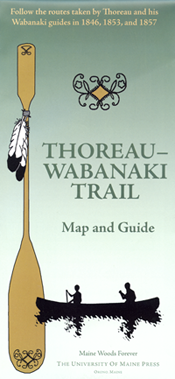Thoreau-Wabanaki Trail Map and Guide
Thoreau-Wabanaki Trail Map and Guide
First in a series. Click here to view second map in the series on the East Branch of the Penobscot River.
Cartography by Michael Hermann, with essays by Richard W. Judd and James Eric Francis, Sr.
 “On the 31st of August, 1846, I left Concord in Massachusetts for Bangor and the backwoods of Maine.“
“On the 31st of August, 1846, I left Concord in Massachusetts for Bangor and the backwoods of Maine.“
Thus Henry David Thoreau began the first of three essays on his travels in the north Maine woods. The Thoreau-Wabanaki Trail commemorates these journeys and the Penobscot Indians who guided Thoreau into the “backwoods of Maine” and deepened his understanding of their vast homeland. Thoreau spent the final months of his life preparing these essays for publication, and his dying words were “Indian” and “moose”—references to his Maine experience. Thoreau was not just another Maine tourist. His three essays, published posthumously as The Maine Woods in 1864, represent American nature writing at its finest. At a time when most Americans celebrated the conquest of nature as Manifest Destiny, Thoreau plumbed its spiritual qualities here in Maine. “In Wildness is the preservation of the World,” he once said, and since the Maine woods was the wildest country he ever explored, it might well be considered the birthplace of the wilderness idea in America.
– Richard W. Judd
Published in association with Maine Woods Forever.
Full-color map, approximately 17″ x 28″, with extensive text.
One double-sided waterproof sheet, 2007; ISBN 978-0-89101-115-3; $8.95
Click here to order this item from our online store.
